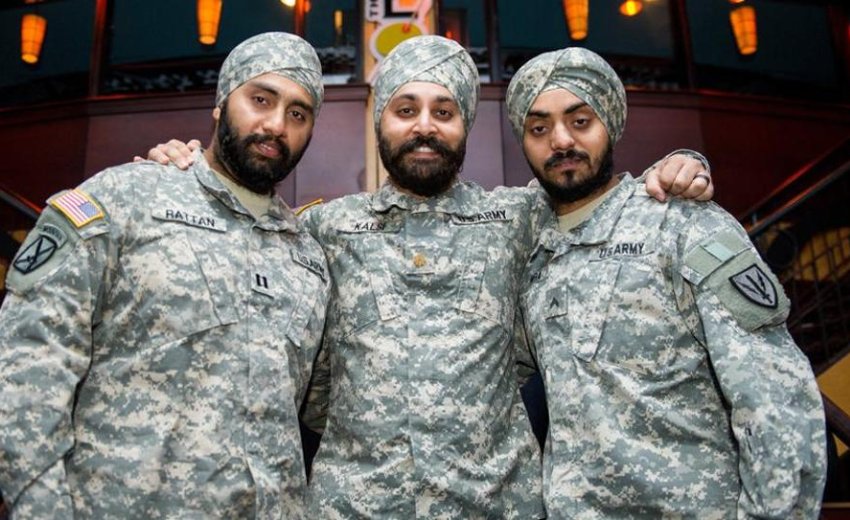Sikhs have been considered the martial race. Since World War I, Sikhs and Sikh Americans have served in the United States military. Sikhs in the US Army have won awards and commendations for their service. The observant Sikhs faced difficulties in serving due to the discontinuation of exemptions to uniform standards that previously allowed them to have untrimmed beards and wear turbans as a part of their uniforms. Bhagat Singh Thind was the first Sikh in US military service to wear a turban while on active duty, even though he was not a citizen of the country.
Uniform regulations lead to restrictions
Before the 1980s, military officers were allowed to wear beards while in uniform. However, regulations changed and the armed forces revoked the permission for beards in uniform, except for those serving before 1986. As the beard is considered indispensable to the Khalsa Sikh as defined by the Rehat Maryada, the current regulation had prevented observant Sikh men from serving in the United States Armed Forces.
In April 2009, with the help of the Sikh Coalition, Sikh Army Captain Kamaljeet S. Kalsi filed an objection against the Inspector General and Department of Defense to remain in his religious apparel. Army reserve Second Lieutenant Tejdeep Singh Rattan, a dentist, also filed the petition. Kalsi joined the Army via the Health Professions Scholarship Program. The recruiter assured him that he would remain in his religiously required clothing while wearing the uniform. Even at West Point and Travis Air Force Base, Kalsi served in uniform without any problems. However, the Pentagon informed Kalsi and Rattan in early 2009 that they would be called to active duty and needed to shave their beards and stop wearing turbans.
The Sikh Coalition argued that denying service members the right to maintain their appearance according to religious beliefs violated the law. Moreover, the Army argued that continued wear of the turban and beard impacted health, safety, and mission requirements, including the use of gas masks. Kalsi was granted an exemption from the policy in late October 2009 and could serve the country while adhering to his religious beliefs. The Army claims these specific changes were made due to the specific circumstances, but the Sikh Coalition claims it will be a shift in policy that will allow other Sikhs to serve in uniform and at the same time practice their beliefs.
A hold was placed on the case of Tejdeep Singh Rattan. A third serviceman, Specialist Lamba, who graduated from Fort Jackson on November 10, was also exempted from this rule and was allowed to swear with an unshaven beard while wearing a turban.
The long road to religious freedom for Sikhs in the U.S. Army
In January 2017, as a result of a lawsuit under the Religious Freedom Restoration Act, regulations were changed allowing religious individuals to wear beards and turbans (this same ruling also allowed Muslims to wear burkas and hijabs). As stipulated in the ruling, regulations can require the beards to be worn at certain lengths (via rolling and clipping) and not interfere with operations.
What caught the headlines was Five Sikhs Inducted into US Army with Religious Accommodation. Five Sikhs had been approved to serve in the US Army with their religious insignia intact, days after the US Army issued regulations allowing servicemen with turbans, hijabs, and beards to be enrolled. After the Department of Defense banned visible articles of faith in 1981, this was the largest induction of Sikhs into the US armed forces.
The new rules, introduced on January 4, 2017, issued by Army Secretary Eric Fanning, allow religious accommodations to be approved at the brigade level. Before this, it was at the level of the Secretary.
According to Sikh Coalition, the religious accommodations bring the new total to at least 14 Sikh American soldiers now serving with their religious articles of faith in the US Army. Under the previous policy, these accommodations involved a burdensome case-by-case process, were brought up the chain of command to the secretary level and were subject to annual review and revocation. Now, they can be granted at the brigade level and can only be revoked if the Army identifies a specific, concrete hazard.
Sikh Coalition Legal Director, Harsimran Kaur said, “After a 35-year presumptive ban on observant Sikhs, our nation’s largest employer has taken a vital step in embracing policies that reflect the rich diversity of our nation.” She said, “We look forward to permanent policy change across all branches of the military so that all religious minorities can freely serve without discrimination."
Under the new military policy, Second Lieutenant Kanwar Singh became the first Sikh to complete the Army's Officer Candidate School. As part of religious accommodation, Airman Harpreetinder Singh Bajwa became the first active-duty airman to serve with a beard, turban, and without shorn hair. The first observant Sikh to graduate from the US Military Academy was Anmol Narang in June 2020.
The Sikh soldier has inherited the legacy of the warrior spirit. He has proven that he is capable of never compromising his beliefs and maintaining his faith while serving in the most demanding situations. He has proven time and time again that he can be Sikh, and a soldier, simultaneously. History stands witness to this.
